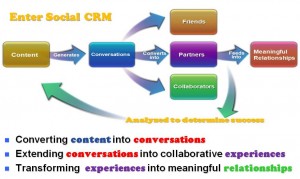Today we added 4 new white iceberg roses across the front of the verandah. They were on sale from Flower Power, 25% off. They are ok to plant outside of winter because they were potted, but we can’t move the other ones until July when they are dormant. We also put some lavender plants across the front of that garden bed, so hopefully they spread over the bed and the chip bark keeps the weeds at bay. The pile of soil is getting much smaller now. On the upcoming long weekend I will be doing some paving and putting in a vegetable patch!
Year: 2009 Page 8 of 16

Social CRM is a buzz word that is spiralling out of control at the moment. What does it mean? I googled around and didn’t really find a consistent message. Instead I am going to explain my interpretation, let me know if you think it makes sense.
Social networks have two strong points, they are full of customers that are linked by relationships. These are the first two letters of CRM! The multi-billion dollar question is how can you manage them without destroying them or being seen as an evil spy.
The first step towards Social CRM is using social networks as a feedback loop for your customer relations programs. Who better to learn from than your customers themselves? It’s the perfect way to refine your customer relations processes and add another source of feedback and innovation into your company.
The next stage is to develop relationships with your customers. From a business perspective I would assume that this is due to repeat business delivering higher margins, mostly because it doesn’t require expensive mass marketing or other customer acquisition. Businesses justify it to consumers by saying it gives the customer an opportunity to dictate and receive a personalised product.
I like idealistic goals, I think when you are talking about customers it is good to at least aim towards being noble. The question is, how many businesses intentions are simply to maintain the margins of their mass market product?
As with everything in life there will be a balancing point, somewhere in the feedback gathering process I think the social networks will reject further interference. That balancing point is what Facebook and others are thinking day and night about, and the point they have crossed at times with projects such as Facebook Beacon. If a social network hits that point perfectly there is definitely big money at stake, but until then companies need to monitor the social networks in their backyard and just listen. There are plenty of companies that struggle to do that internally, let alone through fast moving external networks.

The ACMA's Little Black Book
The Australian Communications and Media Authority, ACMA, is the Government’s media regulating body. They work on a complaints basis, so if content is deemed to be R18+ or to contain excessive amounts of violence, drugs, terrorism etc. then they ban it. They cannot search for new material currently, but instead they review complaints submitted to them (by the public, law enforcement etc.) and then decide whether to ban it or not. This list of banned items is called the ACMA Blacklist.
So why are people so upset about this list? This filtering of content has worked well for movies, why not the internet as well? There are two main areas of thought here:
1) Why is the list black? – The content of the list is not publicly available. In the ACMA’s last report however, 781 overseas sites were added to the list:
- 3 were pedophilia related
- 410 were rated “RC – Child – Depiction”
- 251 were X-rated
- 117 “other” legal content
Previous years showed similar statistics. Wikileaks claims to have the list in full, although of course the ACMA or Senator Conroy would never admit that. This secrecy and the lack of transparency around the reporting process, judgement criteria and the Blacklist itself has people concerned. This was heightened by the leaked Blacklist containing links to popular sites such as YouTube, Geocities and Flickr, as well as plans by Senator Conroy to monitor the blogosphere for dissent.
2) How will it be enforced? – There is enforcement currently in place, Australian websites on the Blacklist can be forcefully taken down. Sites that even link to Blacklisted sites can be fined $11,000, although the irony is that you will never know your link is Blacklisted until it’s too late.
Senator Conroy has decided that the Government needs to be more proactive about this process however, they need to make the filtering mandatory at the ISP level (the company who provides your internet connection). He has setup a live trial with a number of lower tier ISP’s to test his theory, having been rejected by the three big players: Telstra, Optus and Iinet. This opposition is mostly at a technical level, basically arguing that the filter will substantially slow internet access and be largely ineffective (Peer to Peer, Email and other traffic will not be filtered).
Not Happy Jan? You can:
- Join the GetUp Save the Net campaign
- Contact the minister and express your concern
- Leave any ISP that supports the trial
I just hope that they use the inevitably flawed trial as a way out of this sticky web they have weaved. Please try and focus on getting the National Broadband Network right before you cripple our current copper tangle.


